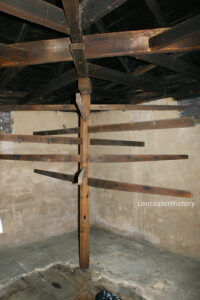Doors in the Sky and on the Ground: The Icehouse and Smokehouse
Of the many doors at Wheatland, the doors to the icehouse and smokehouse catch the eye the most. One door “floats” on the second floor with no visible stairs to access it. The other seems normal enough, but holds a surprise upon opening. These doors typically remained closed, but in today’s blog post, we’re going to take a peak inside.
Two in One
One of the original 1828 outbuildings on the Wheatland grounds, the icehouse and smokehouse boasts a unique all-in-one design. That’s right; the icehouse and smokehouse coexist in one building. The concept seems strange, especially when considering their polar opposite functions. The layout, however, enables a dual function under one roof.
First, the exterior doors were the only way to enter the icehouse and smokehouse in Buchanan’s time. There was no interior access to the other chamber. Some changes did occur to this design post-Buchanan, which we will explore in detail. But first, let’s take a look at the individual chambers.
The Icehouse
The icehouse’s function did not involve food storage. Its function centered entirely on storing ice. The ground-level door gave access to the icehouse. The entrance immediately drops 12 feet below ground. A ladder likely aided in the descent to the pit. At the bottom, ice from local ponds was stored. Sawdust and straw covered the ice for insulation throughout the year.

The Smokehouse
The second floor door, likely accessed by ladder, leads into the smokehouse. Originally, the smokehouse door opened inward. This made logical sense in the 19th century, as opening the door outward would be hazardous to the person on the ladder. (The door could have knocked the person off the ladder!) In present day, however, the smokehouse door opens outward.

Inside the chamber, a meat tree was mounted at the center of the space during Buchanan’s time. The hooks in the smokehouse cannot support cuts of meat larger than game birds such as grouse, pigeons, partridges, turkey and quail. Smoked meat preserved food in a few ways. First, the smoking process dehydrates the meat. Second, the charred meat acts like an acidic coating on the exterior. Both results help to prevent bacteria from growing on the meat.

At some point during the Willson’s residency between 1884 and 1934, someone moved the meat tree from its center mounts, cut out a section of the floor, and installed a hatch style door. The hatch door opening then led to a floor at ground level before reaching the ice house pit. The current floor on the ground level was installed post-1936 and was not present during Buchanan’s lifetime. The icehouse in Buchanan’s lifetime simply consisted of the 12 foot pit.
As seen from the photo below, the flooring of the smokehouse originally was mortar. The hatch door still had this mortar on the surface, too, suggesting that it was made from the cutout of the floor. The opposite side of the hatch door, which would have been the ceiling of the icehouse, had wooden frames installed to add support to the door, lest someone walk on it.

Unique Building, Unique Doors
Doors at Wheatland lead to many destinations, like other rooms or closets. The doors of the icehouse and smokehouse, though, lead to very different chambers. When opened, the doors reveal one building that served two functions in preservation of ice and meats.
Want to learn more about some other doors at Wheatland? Be sure to check out our Instagram for weekly updates!
From History From The House